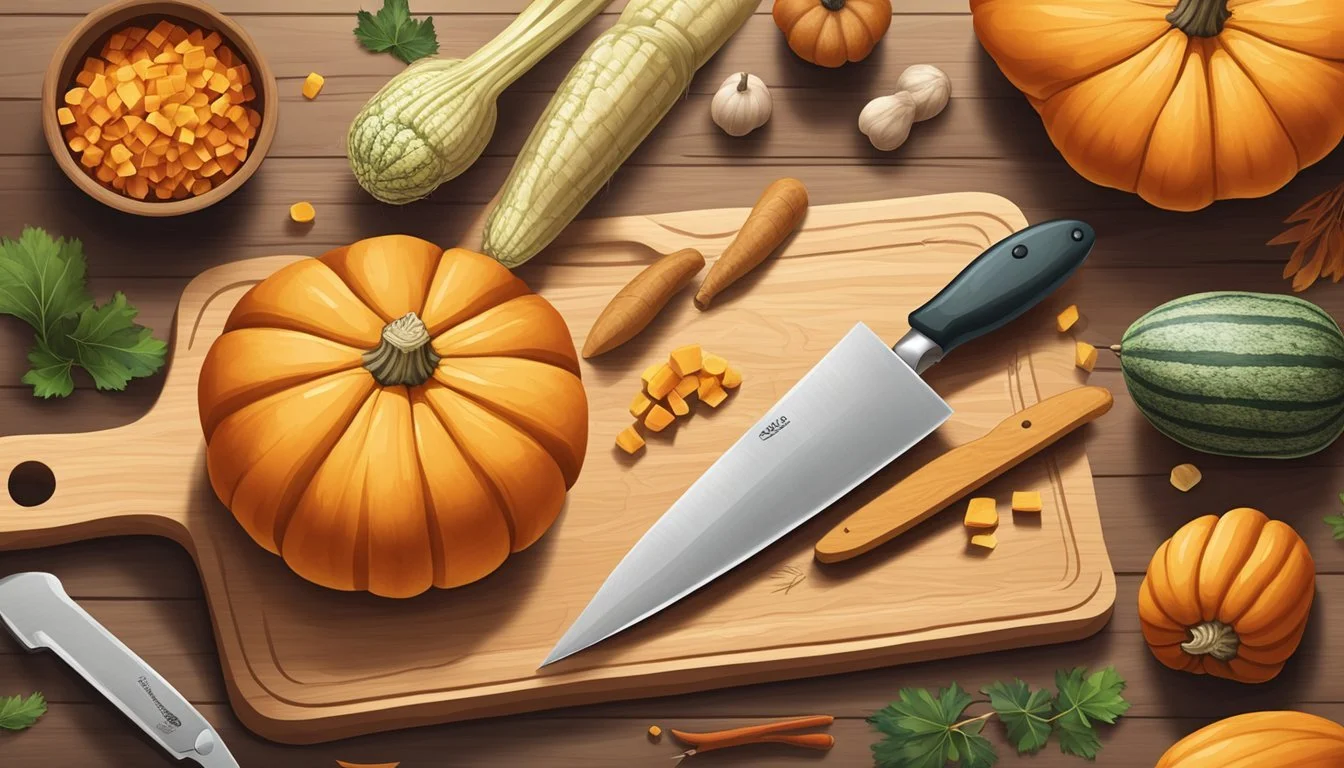Pumpkin Substitutes
Best Alternatives for Cooking and Baking
Finding a good pumpkin substitute is essential for those moments when you simply can't get your hands on this beloved ingredient. Whether you are out of pumpkin or catering to specific dietary needs, butternut squash serves as an excellent 1:1 replacement in most pumpkin recipes.
Sweet potatoes and carrots also provide excellent alternatives with their robust flavors and similar textures. They can be roasted or mashed to achieve a consistency close to pumpkin puree, adding their unique sweetness to your dishes.
For those who prefer fruit-based substitutes, applesauce and mashed bananas offer a different, though equally delicious, twist. These options not only mimic the moisture and binding qualities of pumpkin but also introduce new flavor profiles, making your recipes both innovative and satisfying.
Understanding Pumpkin Characteristics
Pumpkins are versatile ingredients known for their nutritional value, diverse culinary uses, and distinctive texture and flavor profiles.
Nutritional Profile
Pumpkins are rich in vitamins and minerals, particularly vitamin A due to their high beta-carotene content, which contributes to their orange hue. They also provide vitamin C, potassium, and fiber.
Low in calories and fat, pumpkins are a healthful addition to various dishes. A cup of cooked, mashed pumpkin contains about 50 calories, 2 grams of protein, and 3 grams of dietary fiber, making it a nutritious choice for both sweet and savory recipes.
Culinary Uses
Pumpkins are incredibly versatile. In sweet dishes, pumpkin puree is often used in pies, cakes, and muffins, enhancing the recipe with its sweet and slightly nutty flavor.
In savory dishes, pumpkins can be roasted, sautéed, or pureed into soups and stews. Their creamy texture makes them ideal for adding body to sauces and risottos. Pumpkin seeds, or pepitas, can be roasted and used as a crunchy topping for salads and soups.
Texture and Flavor Profiles
The texture of pumpkin is creamy when cooked, making it an excellent base for both baked goods and pureed soups. Raw pumpkin can have a slightly fibrous texture but becomes smooth and tender when cooked.
In terms of flavor, pumpkins have a naturally sweet and slightly nutty taste. This flavor profile is enhanced when pumpkins are roasted, bringing out their natural sugars. The mild sweet flavor makes pumpkins adaptable in various recipes, complementing both sweet and savory ingredients seamlessly.
Overall, the unique combination of creamy texture and distinctive sweet, nutty flavor makes pumpkins a cherished ingredient in many cuisines.
Common Pumpkin Substitutes
When pumpkin is scarce, a variety of alternatives can adequately replace it in recipes. Each substitute has unique characteristics and can often be used in equal measure to pumpkin.
Butternut Squash
Butternut squash is a top substitute due to its similar flavor and texture. It can replace pumpkin in a 1:1 ratio. Roasting enhances its natural sweetness, adding depth to dishes. Both fresh and canned butternut squash can be used, but ensure the canned version is unsweetened to maintain balance.
Dice and roast butternut squash at 400°F until tender, then puree for a smooth consistency.
Sweet Potato
Sweet potato makes an excellent pumpkin alternative, offering a slightly sweeter and earthier flavor. Use it in equal amounts to pumpkin. Roast or boil sweet potatoes until soft, then mash or puree them. This substitute works well in both savory and sweet dishes, adding a rich, moist texture.
Boil sweet potatoes for 20-30 minutes, then mash or process in a food processor for best results.
Acorn Squash
Acorn squash is another winter squash that closely matches pumpkin's flavor and texture. It can be substituted in a 1:1 ratio. Its distinct, nutty taste complements various recipes. Roasting acorn squash before pureeing brings out its natural sweetness, making it a versatile alternative.
Bake acorn squash halves at 375°F for 40-50 minutes before scooping out the flesh.
Hubbard Squash
Hubbard squash is less common but effective as a pumpkin alternative. It has a sweet, slightly dry flesh that works well in a 1:1 substitution. This large, tough-skinned squash requires careful preparation. Typically, it is roasted or boiled before pureeing.
Cut Hubbard squash into manageable pieces and roast at 375°F for an hour, then scoop and puree.
Kabocha Squash
Kabocha squash, or Japanese pumpkin, is an excellent substitute. It boasts a sweet, rich flavor and a texture similar to pumpkin. Use it in equal measure to pumpkin in recipes. Both roasting and steaming work well for preparing kabocha squash. Its dense flesh makes it ideal for pureeing into soups or baking into pies.
Steam kabocha squash chunks for 20-30 minutes until tender, then mash or puree.
Pumpkin Alternatives for Specific Recipes
When cooking or baking, several ingredients can replace pumpkin effectively, maintaining both flavor and texture without compromising on quality. These substitutes vary depending on the type of dish you're preparing.
Baked Goods and Desserts
For pumpkin pies, muffins, and bread, butternut squash makes an ideal substitute due to its similar texture and mild sweetness. Sweet potato is another excellent option, enhancing the richness of desserts. Both can be used on a 1:1 ratio with pumpkin.
In cookies and cakes, applesauce can serve as a valuable alternative, adding moisture without altering the flavor profile significantly. Additionally, banana puree can impart a subtle fruity note while maintaining the required consistency.
Savory Dishes and Casseroles
For savory dishes like casseroles, soups, and stews, acorn squash works well because it has a comparable texture and slightly nutty flavor. Use it in the same quantity as pumpkin.
Carrot and zucchini can also be employed in soups and stews. Carrots provide a sweet, earthy flavor, while zucchini keeps the dish light and fresh. Butternut squash remains a versatile choice here, especially when roasted to enhance its sweetness.
Beverages and Smoothies
In beverages like pumpkin lattes and smoothies, sweet potato can effectively mimic pumpkin's creamy texture and mild sweetness. Carrot puree is another option, delivering a vibrant color and smooth texture.
For a unique twist, peanut butter can be introduced to smoothies, adding creaminess and a nutty flavor that complements the existing ingredients. Ensure all purees are smooth and free of lumps to maintain the beverage's consistency.
Using these alternatives ensures that your recipes remain delicious and visually appealing, even when pumpkin isn't available. Always consider the natural sweetness and the texture of the substitute to achieve the best results.
Alternative Ingredients and Their Prep Methods
When looking to replace pumpkin in a recipe, factors such as seasonality and texture are important. Exploring ingredients like sweet potatoes, carrots, and bananas can offer both versatility and unique flavors.
Seasonal Variations
Sweet Potatoes are an excellent pumpkin substitute available year-round. They are best roasted to enhance their sweetness. To make sweet potato puree, peel and cube the sweet potatoes, roast them until tender, and blend until smooth.
Carrots can also be used. Carrot puree involves boiling or steaming the carrots until soft, then blending them. Apple sauce and mashed bananas are practical, especially when fresh produce is scarce.
Zucchini is abundant in summer. Grate or mash it for recipes requiring a pumpkin substitution. Bananas offer a natural sweetness useful in baking, with mashed bananas providing moisture. Carrot puree, on the other hand, offers a versatile option that adds a touch of sweetness and nutrients to both sweet and savory dishes.
Textural Considerations
When substituting, texture is crucial. Sweet potato puree provides a smooth, creamy consistency akin to pumpkin. Apple sauce is also smooth but adds a hint of tartness which can alter flavor profiles. Mashed bananas offer a creamy texture with a strong banana flavor, suitable for desserts.
Carrot puree and mashed zucchini can vary in texture; the former tends to be smooth, while the latter can be tender but slightly watery. This makes carrot puree ideal for a smoother texture, whereas grated or mashed zucchini works well in soups and breads where moisture variation is tolerated.
Peanut butter offers a thick, smooth texture and adds a rich, nutty flavor. It's not a direct pumpkin replacement but can provide unique profiles in certain recipes.
When preparing these substitutes, roasting or cooking methods enhance their flavors and textures, ensuring they blend seamlessly into your dishes.
Health and Dietary Considerations
When considering substitutes for pumpkin in your diet, it's important to account for various dietary needs such as gluten-free, low sugar, and vegan preferences.
Gluten-Free Substitutes
For those with gluten sensitivities or celiac disease, gluten-free substitutes are essential. Butternut squash is an excellent choice with a texture and flavor similar to pumpkin puree. Additionally, it's naturally gluten-free and can be used in a 1:1 ratio in recipes.
Quinoa can stand in as a gluten-free, grain-based substitute for pumpkin seeds, bringing a crunchy texture when toasted. Its high protein content benefits those needing to maintain their nutritional intake without gluten.
Lower Sugar Options
Reducing sugar intake is essential for many individuals, such as those managing diabetes. Zucchini is a lower-sugar vegetable that can replace pumpkin in both sweet and savory dishes. It has a milder flavor, so adding spices or natural sweeteners like cinnamon and nutmeg can enhance the taste.
For snacks and toppings, almonds offer a nutty flavor with lower sugar content compared to many commercial pumpkin seed snacks. Almonds are also packed with healthy fats and protein, contributing to a balanced diet.
Vegan Alternatives
Vegans need to find substitutes that are free from animal products while still providing essential nutrients. Chia seeds make an excellent substitute for pumpkin seeds, offering omega-3 fatty acids and a unique texture that is versatile in many dishes. They can be used in salads, baking, or even as a topping for vegan yogurt.
Butternut squash again shines as a pumpkin puree substitute in soups, casseroles, and desserts. It's naturally vegan, with a similar texture and flavor profile to pumpkin, making it an easy swap in most recipes.
Culinary Expert Insights
Different experts in the culinary field have shared their unique perspectives on pumpkin substitutes. Notable food writers, professional chefs, and culinary bloggers provide valuable guidance informed by their experiences and expertise.
Notable Food Writers
Food writers, such as Andrew Gray, often explore various culinary topics extensively. In his articles, he highlights butternut squash and sweet potatoes as primary pumpkin substitutes. These ingredients replicate pumpkin's texture and sweetness effectively. Andrew also suggests carrots and zucchini for their versatility in both sweet and savory dishes.
Many notable food writers also emphasize the importance of testing different substitutes to find the best match for each recipe. Their restaurant reviews often include practical examples, illustrating how chefs incorporate these substitutes into their menus. Furthermore, product recommendations from seasoned writers shed light on high-quality canned alternatives available in the market.
Professional Chefs' Recommendations
Professional chefs bring their practical experience to the table. Many chefs recommend using butternut squash due to its similar flavor and texture to pumpkin. In addition, Hubbard squash is frequently mentioned for its dense texture and sweetness, which mimic pumpkin closely.
Chefs like those in fine dining circles often suggest using mashed sweet potatoes or carrots, depending on the dish's flavor profile. For a more adventurous substitute, some chefs have experimented with using bananas or applesauce in baking recipes to maintain moisture and sweetness. Their culinary tips often extend to preparation methods, such as roasting squash to enhance its natural notes.
Culinary Blogging Trends
Culinary bloggers have become influential, often setting trends in home cooking and baking. Recent trends highlight the use of acorn squash, zucchinis, and even peanut butter as unconventional yet effective pumpkin substitutes. Bloggers experiment widely, providing readers with detailed comparisons and recipe ideas.
Popular blogs often include step-by-step guides and videos, making it easier for home cooks to try these substitutes. Bloggers also share personal anecdotes about their culinary trials, adding a relatable element to their recommendations. Moreover, they frequently update their content to incorporate seasonal produce, ensuring their suggestions remain relevant and practical.




